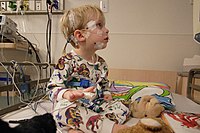
Photo from wikipedia
OBJECTIVE To investigate the association between dose and frequency of prenatal alcohol exposure (PAE) and sleep problems in children, after controlling for established risk factors for sleep problems. METHODS Data… Click to show full abstract
OBJECTIVE To investigate the association between dose and frequency of prenatal alcohol exposure (PAE) and sleep problems in children, after controlling for established risk factors for sleep problems. METHODS Data from the birth cohort of the Longitudinal Study of Australian Children (LSAC) was used. Mothers of 3447 children provided information on alcohol consumption during pregnancy, children's sleep problems from 2- to 9-years, and potential confounders associated with sleep problems. Children were classified into PAE groups based on distinct patterns of maternal drinking during pregnancy: abstinent, occasional, low, moderate, and heavy. The effect of PAE on the number and persistence of sleep problems across childhood (2-9 years) was examined. RESULTS After controlling for multiple covariates that impact sleep, children with heavy PAE had 1.13 more sleep problems across childhood (2-9 years) relative to children whose mothers were abstainers, in particular 0.37 more at 2- to 3-years (0.504, 95 % CI 0.053, 0.956), and 0.34 more at 6- to 7-years (0.847, 95 % CI 0.299, 1.396). Compared to children of abstainers, heavy PAE increases the probability of having persistent sleep problems from 2- to 9-years by 22.57 %. No negative associations between moderate or low PAE and sleep were observed. Parenting, family, economic, and child health factors also significantly affected child sleep. CONCLUSION Heavy PAE was associated with significantly more sleep problems across childhood and a higher probability of reporting persistent sleep problems, relative to children with no PAE. Implications for the understanding and management of sleep in young children with PAE and FASD are discussed.
Journal Title: Drug and alcohol dependence
Year Published: 2020
Link to full text (if available)
Share on Social Media: Sign Up to like & get
recommendations!